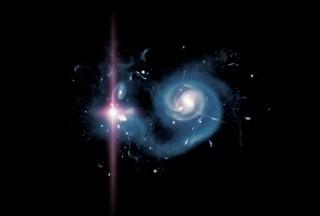
This is an artist's impression of a super-luminous supernova exploding in an interacting and very strongly star-forming galaxy at high redshift. Illustration credit: Marie Martig and Adrian Malec, Swinburne University.
LONDON (PTI): Astronomers have discovered two 'super-luminous' massive stars which exploded 12.5 billion years ago, believed to be the oldest supernovae ever detected.
The cataclysmic events are known as 'superluminous' supernovae, and are up to 100 times brighter than other types of stellar blasts.
They happened only 1.5 billion years after the Big Bang which occurred 14 billion years ago and their detection could eventually lead to finding the first stars that detonated, the 'Daily Mail' reported.
The record easily beats the previous most distant supernova found that was 11 billion years old.
A supernova begins when a star burns out the last of its nuclear fuel and collapses under its own gravity and blasts its outer layers into space.
The star's core is left behind in the condensed form of a neutron star or black hole.
Superluminous supernovae were discovered only a few years ago and are rare in the nearby Universe.
Some are believed to occur when enormous stars undergo a nuclear explosion caused by light particles converting into electron-positron pairs - beams of matter and anti-matter heading in opposite directions.
Such events probably happened more often in the early universe when massive stars were more common.
This and their extreme brightness encouraged Dr Jeff Cooke and colleagues to search for superluminous supernovae when the Universe was less than four billion years old.
The researchers using images from the giant Canada-France-Hawaii Telescope (CFHT) calculated superluminous supernovae were at least ten times more common than now.
"Here we report the detection of two superluminous supernovae that have slowly evolving light curves," Cooke, of Swinburne University of Technology in Melbourne, said.
"The extreme luminosities of superluminous supernovae provide a way of investigating the deaths of the first generation of stars to form after the Big Bang.
"The detection presents the possibility of finding the explosions of the first stars to form after the Big Bang," Cooke said.
The study was published in the journal 'Nature'.
 Next Article
Next Article













The Indian Air Force, in its flight trials evaluation report submitted before the Defence Ministry l..
view articleAn insight into the Medium Multi-Role Combat Aircraft competition...
view articleSky enthusiasts can now spot the International Space Station (ISS) commanded by Indian-American astr..
view article